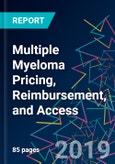Highlights:
Interviewed payers highlight pricing negotiations with manufacturing companies as a key cost-control measure, ensuring pricing premiums are only granted to therapies demonstrating significant improvements in patient outcomes in comparison to existing alternatives. In contrast, payers in the US have limited power to control expenditure on multiple myeloma therapies, despite the imposition of utilization management mechanisms. Manufacturing companies are relatively free to set the prices of their multiple myeloma treatments, with payers reluctant to impose prescribing and access restrictions within high-severity oncology indications.
- The budget impact of multiple myeloma is set to increase
- While multiple myeloma represents a relatively small patient population in comparison to other cancers, payers are concerned about the rising spend on the indication. New biologic therapies are increasingly gaining label expansions in earlier treatment lines, and with life expectancies improving, patients are requiring treatment with expensive therapies for longer durations of time. Furthermore, with patients often treated with triple regimens, and many quadruple combinations of newer market entrants making up the late-stage pipeline, payers express concern surrounding the increasing use of combination regimens within multiple myeloma. Combination therapies are a particular challenge for payers, as most markets lack the tools for effective pricing and reimbursement negotiations for these products.
- Various expenditure controls are in place for multiple myeloma therapies across Europe
- While not specific to multiple myeloma therapies, various control mechanisms are in place across the five major European markets (France, Germany, Italy, Spain, and the UK) to limit overspending on therapeutics in general.
Interviewed payers highlight pricing negotiations with manufacturing companies as a key cost-control measure, ensuring pricing premiums are only granted to therapies demonstrating significant improvements in patient outcomes in comparison to existing alternatives. In contrast, payers in the US have limited power to control expenditure on multiple myeloma therapies, despite the imposition of utilization management mechanisms. Manufacturing companies are relatively free to set the prices of their multiple myeloma treatments, with payers reluctant to impose prescribing and access restrictions within high-severity oncology indications.
Table of Contents
OVERVIEWPRICINGUS
REGULATORY LABELS
GLOBAL ACCESS LEVERS
EVIDENCE AND VALUE
ACCESS TO RECENTLY APPROVED AND PIPELINE DRUGS
Insights and strategic recommendations
CANADA
JAPAN
FRANCE
GERMANY
ITALY
SPAIN
UK
METHODOLOGY
List of Figures
LIST OF TABLES








